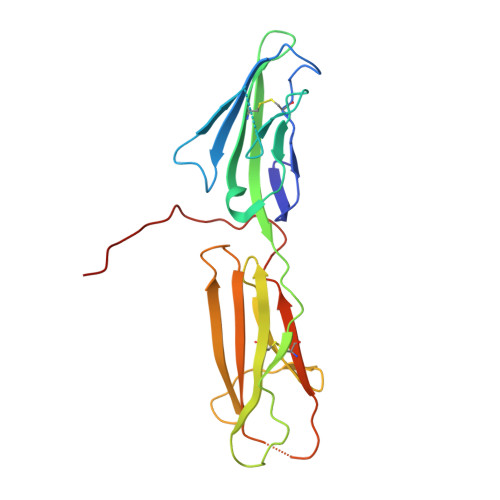Stable RAGE-Heparan Sulfate Complexes Are Essential for Signal Transduction.
Xu, D., Young, J.H., Krahn, J.M., Song, D., Corbett, K.D., Chazin, W.J., Pedersen, L.C., Esko, J.D.(2013) ACS Chem Biol 8: 1611-1620
- PubMed: 23679870
- DOI: https://doi.org/10.1021/cb4001553
- Primary Citation of Related Structures:
4IM8 - PubMed Abstract:
RAGE (Receptor for Advanced Glycation End-Products) has emerged as a major receptor that mediates vascular inflammation. Signaling through RAGE by damage-associated molecular pattern molecules often leads to uncontrolled inflammation that exacerbates the impact of the underlying disease. Oligomerization of RAGE is believed to play an essential role in signal transduction, but the molecular mechanism of oligomerization remains elusive. Here we report that RAGE activation of Erk1/2 phosphorylation on endothelial cells in response to a number of ligands depends on a mechanism that involves heparan sulfate-induced hexamerization of the RAGE extracellular domain. Structural studies of the extracellular V-C1 domain-dodecasaccharide complex by X-ray diffraction and small-angle X-ray scattering revealed that the hexamer consists of a trimer of dimers, with a stoichiometry of 2:1 RAGE:dodecasaccharide. Mutagenesis studies mapped the heparan sulfate binding site and the interfacial surface between the monomers and demonstrated that electrostatic interactions with heparan sulfate and intermonomer hydrophobic interactions work in concert to stabilize the dimer. The importance of oligomerization was demonstrated by inhibition of signaling with a new epitope-defined monoclonal antibody that specifically targets oligomerization. These findings indicate that RAGE-heparan sulfate oligomeric complexes are essential for signaling and that interfering with RAGE oligomerization might be of therapeutic value.
Organizational Affiliation:
Department of Cellular and Molecular Medicine, Glycobiology Research and Training Center, University of California, San Diego , La Jolla, California 92093, United States.














